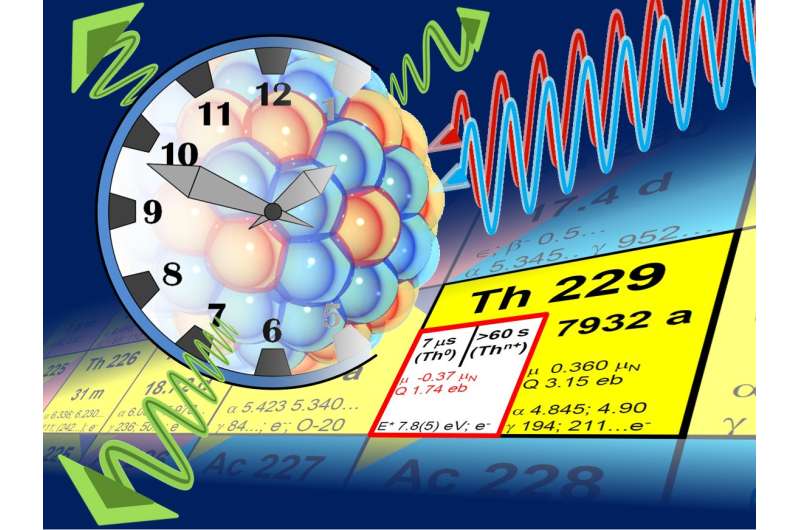En route to the optical nuclear clock

The nucleus of thorium-229 possesses a property that is unique among all known nuclides: It should be possible to excite it with ultraviolet light. To date, little has been known about the low-energy state of the Th-229 nucleus that is responsible for this property. Together with their colleagues from Munich and Mainz, researchers at the Physikalisch-Technische Bundesanstalt (PTB) have now performed the first-ever measurements - using optical methods - of some important properties of this nuclear state such as the shape of its charge distribution. In this way, a laser excitation of the atomic nucleus can be monitored, thus allowing an optical nuclear clock to be realized that "ticks" more precisely than present-day atomic clocks. The scientists have reported their results in the current issue of Nature.
As early as around 15 years ago, Ekkehard Peik and Christian Tamm were developing the concept of a new atomic clock that had unique properties at PTB in Braunschweig: Instead of a transition frequency between two states in the electron shell being used as the pulse generator of their clock, as is the case in all atomic clocks in use today, they envisaged using a transition frequency in the nucleus. Because the protons and neutrons in the nucleus are packed more densely than the electrons in the atomic shell by several orders of magnitude, they react less sensitively to outside disturbances that can change their transition frequencies - thus providing good conditions for a high-precision clock.
However, the frequencies of nuclear transitions are also much higher than those of shell transitions (in the X-ray range); for this reason, they are unusable for atomic clocks, which, to date, have been based exclusively on microwaves or laser light. The sole known exception, and the foundation of PTB's proposal, is the nucleus of thorium-229. This nucleus possesses a quasi-stable, isomeric nuclear state at exceptionally low excitation energy. Thus, a transition exists between the ground state and this isomer, which is in the frequency range of ultraviolet light, and thus within the reach of laser technology that is similar to that used in present-day optical atomic clocks.

More than ten research groups around the world are currently working on projects concerning the feasibility of a thorium-229 nuclear clock. In experimental terms, this issue has proven to be extremely difficult. For this reason, no success has been achieved thus far in observing the nuclear transition using optical methods, as knowledge of the precise excitation energy of the isomer has been only approximate. "As desired for the clock, the resonance of the transition is extremely sharp and can only be observed if the frequency of the laser light precisely matches the energy difference of both states. The problem therefore resembles the proverbial search for a needle in a haystack," says Dr. Peik.
In 2016, Dr. Peik's cooperation partners at Ludwig-Maximilians-Universität (LMU) in Munich reported on their first breakthrough in Nature: For the first time, they were able to prove the nuclear transition within the thorium-229 nucleus, even though the methods they used were very different from those used for an atomic clock.
This collaborative research project - which, in addition to PTB and LMU scientists, also includes scientists from Johannes Gutenberg University Mainz, the Helmholtz Institute Mainz and GSI Helmholtzzentrum für Schwerionenforschung Darmstadt - has now taken another decisive step: For the first time, it has been possible for basic properties such as the size and shape of the charge distribution to be measured in the excited state of the Th-229 nucleus. To this end, the Th-229 nuclei were not excited from their ground state (as will happen in the future in the clock); instead, in a device developed by LMU, they were obtained in the excited state from the alpha decay of uranium-233, slowed and stored as Th2+ ions in an ion trap. A uranium-233 source suitable for this purpose was provided by the groups in Mainz and Darmstadt. By means of laser systems developed at PTB for the spectroscopy of these ions, it was possible to measure transition frequencies in the electron shell accurately. Because these frequencies are directly influenced by the nuclear properties, they can be used to obtain information on these properties. To date, models based solely on theory have not been able to predict how the structure of the Th-229 nucleus will behave during this unusually low-energy transition. Furthermore, because the structure of the electron shell is easier to measure using spectroscopy, it has become possible to use it to demonstrate a laser excitation of the nucleus.
However, even if this does not mean that the search has been completed for the optical resonant frequency of the Th-229 nucleus (the "needle in the haystack"), we now know what the needle actually looks like, bringing us a significant step closer to the optical atomic clock.
More information: Laser spectroscopic characterization of the nuclear-clock isomer 229mTh, Nature (2018). nature.com/articles/doi:10.1038/s41586-018-0011-8
Journal information: Nature
Provided by Physikalisch-Technische Bundesanstalt




















